

Casaecologica. A Casa Biyuka no llega el camión de basura, osea que tenemos que lidiar con nuestra basura.
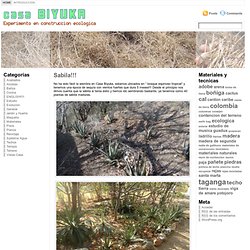
Desde el principio hemos reciclado lo que sabíamos que podíamos llevar a Santa Marta (ciudad que esta muy cerca) para vender a los centros de reciclaje. estábamos separando lo orgánico que utilizamos en el jardín como compost y separando el papel/cartón, el vidrio / los metales y los plásticos. Calentador solar gratis con botellas PET. Hace ocho años José Alano, un mécanico brasileño retirado, tuvo la inspiración de recoger botellas de plástico (PET) y cartones de leche usados para desarrollar un sistema de calentamiento de agua por energía solar simple, barato y que pudiera construir cualquier persona.
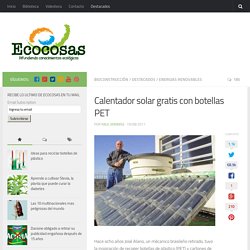
The Ecologist le dedica un estupendo artículo contando su historia:…viendo que en su pequeño pueblo de Tubarão no existía ninguna infraestructura para reciclar los envases y sintiéndose incapaces de tirar todos esos envases a la basura, Alano y su mujer pronto se encontraron con una habitación llena de botellas y cartones de leche vacíos. […] Haciendo uso de su ingenio y experiencia con captadores solares, él y su esposa construyeron una versión alternativa utilizando 100 botellas PET y 100 cartones de leche usados. El prototipo funcionó a la perfección, al tiempo que dieron una nueva vida a todos esos desperdicios de manera responsable. Instructivo grafico: Refrigerar alimentos sin electricidad. El invento denominado “Pot-in-pot” fue desarrollado por Mohamemed Bah Abba , residente del norte de Nigeria en donde el 90% de las aldeas no poseen electricidad.
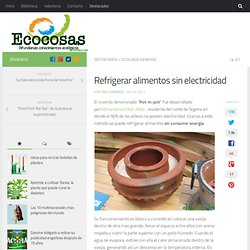
Gracias a este método se puede refrigerar alimentos sin consumir energía. Su funcionamiento es básico y consiste en colocar una vasija dentro de otra mas grande, llenar el espacio entre ellos con arena mojada y cubrir la parte superior con un paño húmedo. Cuando el agua se evapora, extrae con ella el calor almacenado dentro de la vasija, generando así un descenso en la temperatura interna. Es un proceso natural, barato y fácil de elaborar. Composting Toilets by Sun-Mar - Products. Architecture: Vision. Atelier Werner Schmidt. Congreso.pucp.edu.pe/terra2012/docs/programa.pdf. Strohballenbau und Baubiologie. Terra europae by DIDA. Vernacular Heritage and Earthen Architecture. In a continuously changing world, there has been a growing interest in the protection of vernacular heritage and earthen architecture.

The need to protect and enhance this fragile heritage via intelligent responses to threats from nature and the environment has become evident. Historically, vernacular heritage research focussed on philosophical aspects and surveys, while earthen architecture studies emphasized earthen material and construction techniques. However, for these particular forms of heritage to survive, academic research had to shift its focus, so as to respond to new challenges.
Vernacular Heritage and Earthen Architecture gathers contributions of key international researchers from 50 countries, and covers a wide variety of topics: • Cultural heritage and building cultures • Materials and construction techniques • Territory and environmental adaptation. Conference in Marseille. EUROPEAN SYMPOSIUMOn Wednesday, 4 and Thursday, May 5th, 2011Region of Provence-Alpes-Côte d'AzurHôtel de Région – 27 place Jules Guesde – Marseille (2e) Building with earthFrom Cultural Heritage to Contemporary ArchitectureProfessionals, Know-how and Techniques in Europe It is organised by the Ecole d'Avignon (France), in partnership with the Escola Superior Gallaecia (Portugal), the University of Valencia (Spain), the University of Florence (Italy) and the Adviser in Architecture, Urban planning and environment (CAUE) of Vaucluse (France), in the framework of the European project Terra Incognita.
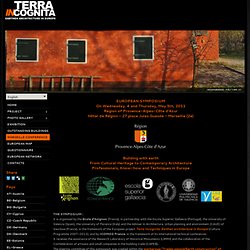
Earthen architecture in Europe (Culture Programme 2007-2013), and by ICOMOS France, in the framework of its international technical conferences. It receives the assistance of the Research Laboratory of Historical Monuments (LRMH) and the collaboration of the Confederation of artisans and small companies in the building trade (CAPEB). Registration fees are supported by the organizers. Bioarquitectura Mediterránea. Architecture. Sun Infinite Energy. Solar Millennium AG - Egypt rsquo s first solar-thermal plant goes into operation in Kuraymat - Archives - Press - Press Releases - Archive 2010.
Solar Millennium’s subsidiary Flagsol has delivered the technology for the region’s first solar-thermal plantHybrid power plant with 150 MW capacity will use solar energy and natural gas and can be operated around the clockCommissioning as an important indication that the DESERTEC concept can be realized Erlangen/Cologne/Kuraymat (Egypt), 23 December 2010 In Kuraymat, roughly 100 kilometers south of Cairo, a major solar-thermal power plant is going into operation for the first time in Egypt.
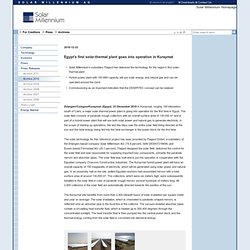
The solar field consists of parabolic trough collectors with an overall surface area of 130,000 m² and is part of a hybrid power plant that will use both solar power and natural gas to generate electricity. In the scope of starting up operations, the last few days saw the entire solar field being directed at the sun and the heat energy being fed into the heat exchanger in the power block for the first time. You can download the press release here. On-Site: Integrated Solar Combined Cycle Power Plant of Kuraymat. Located some 90 kilometers south of Cairo and in reaching distance of the water sources of the River Nile, the integrated solar combined cycle power plant of Kuraymat is a first example of large-scale use of solar energy in Egypt.

The Kuraymat location features a high intensity direct solar radiation of more than 2,400 kilowatt hours per square meter and year. Put into commercial operation in June 2011, the project is based on parabolic trough technology integrated in a combined cycle power plant using natural gas as fuel. At a total capacity of 140 MW and total investment of US$ 340 million, the capacity of the solar island is 20 MWel or approximately 61 MWth. Solar islands at the integrated solar combined cycle power plant of Kuraymat, Egypt. Image courtesy Paul Langrockt, Solar Millennium. The project layout does not include a stand-alone solar solution; neither does it contain heat storage. Bright Thinking in Solar. Home - Flagsol GmbH. Loam Clay Earth, Martin Rauch, Vorarlberg.